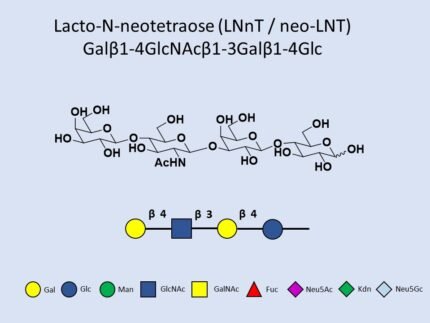UDP-2-Alkyne-GlcNAc (Uridine Diphosphate 2-Alkyne-N-Acetylglucosamine) is a modified nucleotide sugar used in biochemical research, particularly in glycosylation studies and bioorthogonal chemistry. It consists of UDP linked to 2-alkyne-N-acetylglucosamine (GlcNAc), where an alkyne group replaces the hydroxyl group at the 2-position of the GlcNAc sugar.
Structure & Properties:
- Molecular Weight (MW): Approximately 645 g/mol (depends on the specific form)
- Chemical Formula: C20H29N3O17P2 (approximate)
- Synonyms: UDP-2-alkyne-N-acetylglucosamine
- Functional Groups: The alkyne group at the 2nd position of the GlcNAc sugar makes it reactive and suitable for bioorthogonal chemical reactions.
Biological Role:
- Metabolic Labeling: UDP-2-Alkyne-GlcNAc is used in metabolic labeling experiments where it is incorporated into glycans during glycosylation. The alkyne group allows for bioorthogonal reactions, such as click chemistry, enabling precise labeling and tracking of glycan structures.
- Function: This modified sugar acts as a substrate for glycosyltransferases in cells and becomes part of glycoproteins and glycolipids. The alkyne group provides a site for further chemical modifications.
Applications:
- Click Chemistry: The alkyne group allows for reactions like azide-alkyne cycloadditions, which are used to label or modify biomolecules in living cells or complex biological systems.
- Glycan Profiling: UDP-2-Alkyne-GlcNAc is widely used to label glycans, facilitating the analysis of glycosylation pathways and the roles of glycans in various cellular functions.
Significance in Research:
- Glycobiology Research: This compound is a powerful tool in studying glycan biosynthesis, dynamics, and cellular trafficking. It allows for visualization and characterization of glycosylation in living cells.
- Bioorthogonal Labeling: UDP-2-Alkyne-GlcNAc’s alkyne functionality enables efficient chemical labeling of glycans, which can be tracked using fluorophores or other probes.
Key Roles:
- Glycoprotein Labeling: UDP-2-Alkyne-GlcNAc can be incorporated into glycoproteins, which can then be labeled with detection tags through click chemistry for imaging or functional studies.
- Targeted Drug Delivery: The alkyne modification allows for targeted labeling or attachment of therapeutic agents to glycans on specific cells or tissues.
Storage and Stability:
- Storage: UDP-2-Alkyne-GlcNAc should be stored at -20°C in a dry, moisture-free environment.
- Stability: It is stable under proper storage conditions but may degrade upon exposure to light, heat, or moisture.
Research Applications:
- Glycosylation Studies: UDP-2-Alkyne-GlcNAc is commonly used in research focused on understanding the mechanisms of glycosylation and its effects on cell biology.
- Cell Surface Engineering: It is used in synthetic biology to modify cell surface glycans for therapeutic, diagnostic, or research purposes.
Potential Impact:
- Therapeutic Development: Insights gained from using UDP-2-Alkyne-GlcNAc in glycosylation studies could lead to new therapeutic strategies targeting abnormal glycosylation in diseases such as cancer or inflammatory conditions.
- Synthetic Biology: This modified sugar is a valuable tool for engineering cells with custom-designed glycan structures, which can be used in novel therapeutic and diagnostic applications.
Key Research Areas:
- Cancer Research: UDP-2-Alkyne-GlcNAc is useful in studying glycosylation changes in cancer cells, helping researchers understand how altered glycosylation contributes to tumor progression and metastasis.
- Immunology: The tool is employed to study how glycosylation influences immune cell function and interactions, potentially informing the development of immune-based therapies.
Conclusion:
UDP-2-Alkyne-GlcNAc is a critical reagent in glycosylation research, enabling precise chemical labeling and modification of glycan structures. Its utility in click chemistry and bioorthogonal reactions makes it an indispensable tool for advancing our understanding of glycosylation in biology, disease, and therapeutic development.
















Reviews
There are no reviews yet.